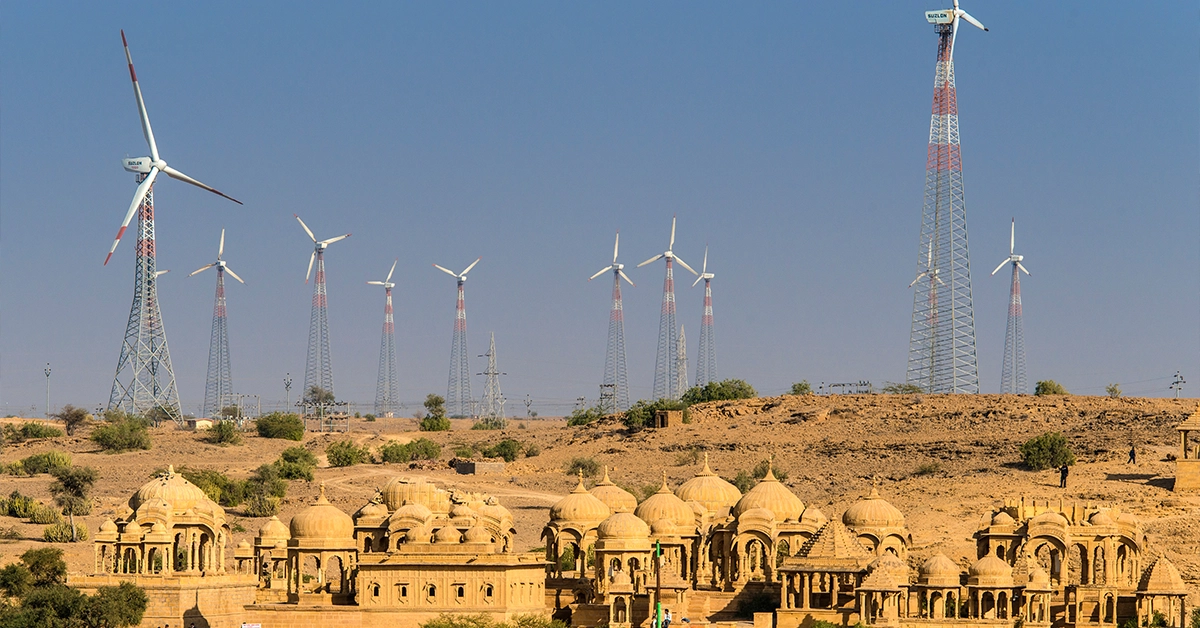
However, late mover advantage can also be evident when technology allows a society or an entire nation to bypass decades of technological progress. The new technology makes everything previously built obsolete. Think of remote and impoverished regions in Africa that adopted cell phones, removing the need for building and maintaining landlines.
India is poised to use late mover advantage on a structural scale when it comes to its energy sector. Here are 3 key reasons why we think India is poised for a green energy revolution:
Excellent solar conditions throughout the entire Indian subcontinent
Located around the Tropic of Cancer, most of India experiences consistent sunny weather through most of the year. Solar energy is not being harnessed just by large, government-built and grid-connected power plants, but also in off-grid settings for many of the country’s rural poor who are disconnected from the national power grid. Here is a detailed map of solar radiation throughout the country. The government plans to increase solar power generation to 100 GW by 2022. Throughout 2017, the World Bank assisted India in achieving this goal by lending more than $1 billion. This is the Bank’s largest-ever support for solar power in any country. India is also the founder of the International Solar Alliance (ISA), an international initiative of more than 121 countries led by India. Their mission is to “bring together a group of nations to endorse green energy, sustainable environment, public transport, and climate”. In short, India is making full use of its incredible solar potential.
Large rivers and regular monsoons provide hydroelectric potential
India is home to some of the world’s largest rivers by volume, including the Great Indus, the Ganga and the Brahmaputra. The northern and eastern parts of India are located on the foothills of the Himalayan plateau, containing countless streams and small rivers that are utilized in micro- and pico-hydropower plants. The hydroelectric power plants at Darjeeling (1898) and Shivanasamudram (1902) were among the first in Asia. Currently, India has a total of 36.8 GW of installed hydroelectric capacity.
India’s total economically exploitable and viable hydroelectric potential is estimated to be 301.117 GW at 60% load factor. Hydropower projects are often remotely located and are crucial to stabilising the grid as they provide a reliable and consistent source of energy.
A government and society that is eager for new technologies and innovation
India’s interest in renewable energy is underlined by the existence of its Ministry of New and Renewable Energy (MNRE), devoted to the research of new energy resources and the improvement of existing renewables (solar, wind and water predominantly). A study by Ernst and Young ranked India as 4th in the world in terms of renewable energy attractiveness.
India is known for its lucrative IT sector. While the total number of employees is insignificant in comparison to India’s total population (2.8 million people work in these sectors vs. India population of 1.34 billion), it represented disproportionately large revenues of $167 billion USD in 2017 or around 7.7% of the country’s GDP.
India is uniquely poised to make use of these conditions and gain late mover advantage by adopting renewable energy on a nationwide level. A 2017 study made by the Lappeenranta University of Technology found that India can function on a fully renewable electricity system by 2050. The study shows that developing countries that have an abundance of renewable resources do not need to take the path of the developed countries which sacrificed carbon emissions in order to raise living standards (through increased energy usage). India will be capable of making the leap straight to a renewable-powered economy, massively reducing its carbon footprint and bringing long-needed stability and consistency to its national power grid.
The world’s largest democracy is embracing renewable technology and is well on its way to becoming one of the largest providers of green energy. India has an estimated renewable energy potential of about 1096 GW from commercially exploitable sources. The people and the government of India are eagerly anticipating their nation’s transition to clean, green energy.
In our concluding article on the Indian energy sector, we will examine how FUERGY can provide immediate benefits to the people of India and how it will assist in the government’s ambitious long-term renewable energy goals. Read our other articles or contact us today! Our experts are here to help you find a tailor-made solution to your needs.
New dimension of energy optimization





